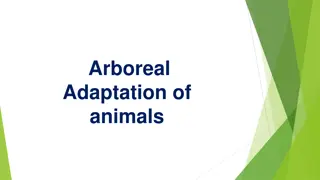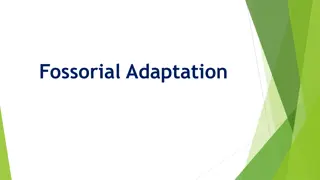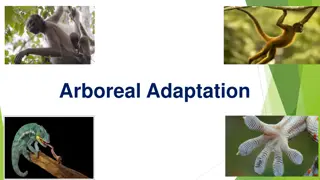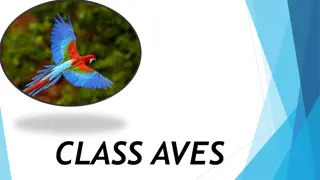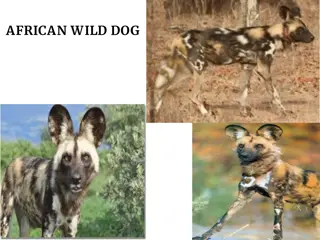Arboreal Adaptation of Chameleons
Chameleons, known for their arboreal lifestyle, possess unique adaptations for tree-dwelling, such as specialized feet for gripping branches and a long tail for balance. Their ability to change body color, protrusible tongue for catching prey, and sharp claws further enhance their survival in arbore
0 views • 19 slides
Understanding Fossorial Adaptation in Animals
Animals adapt to subterranean environments through anatomical and physiological modifications in a process known as fossorial adaptation. This adaptation involves creating subterranean zones through digging, leading to changes influenced by both the environment and the animals themselves. Fossorial
0 views • 17 slides
Understanding Arboreal Adaptation in Animals
Arboreal locomotion refers to the movement through trees exhibited by animals like squirrels, sloths, and monkeys. These animals possess physical adaptations such as long limbs, prehensile tails, and claws to aid in tree climbing. Arboreal life offers safety, retreat, and easy access to food, shapin
0 views • 14 slides
Understanding the Common Integuments and Skin Anatomy
The common integuments encompass the skin, hairs, skin glands, claws, hooves, and horns, playing vital roles in protection, thermoregulation, and drug administration. The skin's structure consists of the epidermis and dermis layers, renewing continuously to maintain its functions. Additionally, nail
0 views • 11 slides
Impact of Tail Docking on Pedigree Dog Culture in NZ: Focus on Judging Selected Breeds
The NZDJA Annual Conference 2019 addressed the contentious issue of tail docking and its repercussions on the culture of pedigree dogs in New Zealand, with a specific focus on judges and selected breeds. This practice, historically influenced by pressure from animal activist groups and veterinary co
0 views • 25 slides
Life of a Lion in the African Savannah
Living near cheetahs and other members of the cat family, lions thrive in the African Savannah hunting antelopes, warthogs, and zebras. Known for their majestic looks, lions have sharp claws and fur in various shades. They can be found in open woodlands and grasslands, often in prides. Lions prefer
0 views • 13 slides
Mastering Claw Curvature Measurement Technique
Learn how to measure claw curvature using a step-by-step technique involving drawing chords, perpendicular lines, and measuring angles with a protractor. Practice the method on various bird claws such as Belted Kingfisher, Atlantic Puffin, Common Eider, Greater Black-backed Gull, and Great Blue Hero
0 views • 9 slides
Classification of Class Aves and its Sub-Classes
Class Aves is divided into two sub-classes based on characteristics like teeth, claws, and bone structure. The sub-classes are Archaeornithes and Neornithes, each with distinct features and orders. Archaeornithes include the extinct order Archaeopterigiforms, exhibiting reptilian and avian traits. N
0 views • 13 slides
Diseases of Skin Overview and Primary Lesions by Dr. Sonam Bhatt, Assistant Professor VMD Basu Patna
Skin, the largest organ of the body, plays a crucial role in regulating temperature and acting as a protective barrier. It consists of the epidermis, dermis, and subcutis, along with skin appendages like hair and claws. Skin lesions can be categorized into primary and secondary, with primary lesions
0 views • 18 slides
Tiger Adaptations and Characteristics
Tigers possess unique adaptations such as their striped coat for camouflage, sensitive hearing capable of picking up infrasound, retinas that reflect more light, sharp claws for hunting and climbing, large teeth for catching prey, a long tail for balance while running, and a powerful roar when threa
0 views • 9 slides
Fascinating Facts About African Wild Dogs
African wild dogs, also known by various names, are unique canids with a distinct genetic makeup. They are medium-sized with mottled coats and no dew claws, living in social packs where only the alpha pair breed. Each dog has a unique spot pattern, and they excel at hunting from a young age. Learn m
0 views • 14 slides
Impact of Learner Errors on Automatic Part-of-Speech Tagging with CLAWS
This study investigates the impact of learner errors on the performance of the CLAWS tagging system when tagging Estonian learner English. Learner language, characterized as dynamic and variable, plays a crucial role in the accuracy of part-of-speech tagging. Factors influencing errors in learner la
0 views • 22 slides
